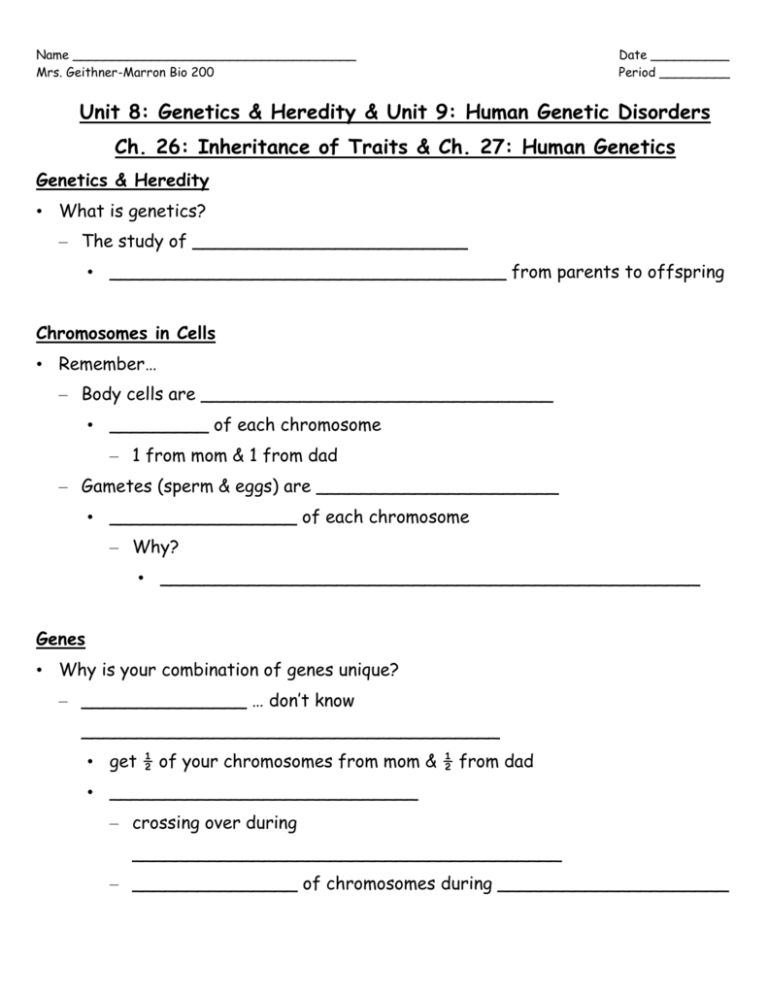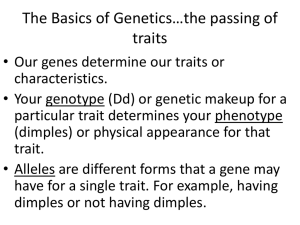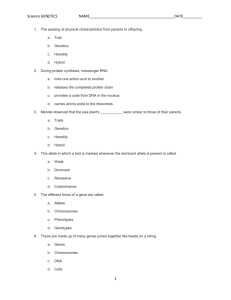Phenotypes - Mrs. GM Biology 200
advertisement

Name ____________________________________ Mrs. Geithner-Marron Bio 200 Date __________ Period _________ Unit 8: Genetics & Heredity & Unit 9: Human Genetic Disorders Ch. 26: Inheritance of Traits & Ch. 27: Human Genetics Genetics & Heredity • What is genetics? – The study of _________________________ • ____________________________________ from parents to offspring Chromosomes in Cells • Remember… – Body cells are ________________________________ • _________ of each chromosome – 1 from mom & 1 from dad – Gametes (sperm & eggs) are ______________________ • _________________ of each chromosome – Why? • _________________________________________________ Genes • Why is your combination of genes unique? – _______________ … don’t know ______________________________________ • get ½ of your chromosomes from mom & ½ from dad • ____________________________ – crossing over during _______________________________________ – _______________ of chromosomes during _____________________ Name ____________________________________ Mrs. Geithner-Marron Bio 200 Date __________ Period _________ Genes & Alleles • What is a "gene"? – section of ___________________________________________________ ___________________________________________________________ • & determines a specific __________ (ex. hair color, eye color, etc.) – genes are ___________________________________________________ • different forms of genes for the same trait are called “________________” Dominant & Recessive Alleles • Each parent contributes __________________________________________ _____________________________________________________________ – What is a dominant allele? • allele that _______________________________________________ – What is a recessive allele? • allele whose trait can _______________________ when the organism is _____________________________________________ for that trait • How are alleles represented? – with _____________________________ • usually the _______________________ of the ____________________________ – If the same letter is used for dominant & recessive, how do we know which allele is which? • CAPITAL = ___________________________ • lowercase = ___________________________ Name ____________________________________ Mrs. Geithner-Marron Bio 200 Date __________ Period _________ Allele Combinations • What does "homozygous" mean? – both alleles are ____________________________ • _____________________________________ (pure) dominant (ex. AA) • _____________________________________ (pure) recessive (ex. aa) • What does "heterozygous" mean? – both alleles are _______________________________ • ___________________________________________ (hybrid) (ex. Aa) Genotype vs. Phenotype • What is "genotype"? – organism's actual _____________________________________________ ___________________________________________________________ • What does the genotype do? – codes for ___________________________________________________ • How do we represent an organism's genotype? – ___________________________________________________________ • one from mom & one from dad – ex. ___________________________________________________ • What is "phenotype"? – the _______________________________ of the genotype ("trait we see") • What actually causes the "phenotype" (trait) we see? – the ______________ that is __________________ (due to the organism's genotype "code"/alleles) • How do we represent an organism's phenotype? – usually an __________________________ • ex. __________________________________________________ etc. Name ____________________________________ Mrs. Geithner-Marron Bio 200 Date __________ Period _________ Genotype is Expressed as a Phenotype • Ex. Let P = purple & p = white – homozygous (pure) dominant • genotype _________ • phenotype = _________ – heterozygous (hybrid) • genotype _________ • phenotype = _________ – ___________ trait "masks/ hides" ____________ trait – homozygous (pure) recessive • genotype _________ • phenotype = _________ Predicting Traits in Offspring • What are Punnett Squares? – a way to ____________________________________________________ • letters outside represent ____________________________________ ________________________________________________________ – top = _______________________ & side = ____________________ • letters inside boxes represent ________________________________ ________________________________________________________ ________________________________________________________ – can be used to determine ___________________________________ Name ____________________________________ Mrs. Geithner-Marron Bio 200 Making a Punnett Square Date __________ Period _________ Making a Punnett Square • Parents are Tt & tt genotypes… 1. Determine the genotypes of the parent – So… Tt x tt is our cross organisms. 2. Write down your "cross" (mating). 3. Draw a Punnett square. 4. "Split" the letters of the genotype for each parent & put them "outside" the Punnett square (one on left & one on top) to represent the possible alleles in the gametes. 5. Determine possible genotypes of the offspring by filling in the Punnett square. 6. Summarize results (genotypes & phenotypes of offspring) Parent Pea Plants ("P" Generation) o Genotypes: __________________________ o Phenotypes: __________________________ Offspring ("F1" Generation) o Genotypes: __________________________ o Phenotypes: __________________________ Passing Traits to Offspring & Probability • What is probability? – ______________ an event will occur – What is the chance of getting heads? tails? ____________ – If you flip two coins, of getting 2 heads? 2 tails? ___________ – What is the chance of a couple having a boy? a girl? ___________ – Of having five girls? • 1/2 x 1/2 x 1/2 x 1/2 x 1/2 = ______________ – or (1/2)5 = ___________ Name ____________________________________ Mrs. Geithner-Marron Bio 200 Date __________ Period _________ Passing Traits to Offspring & Ratios • What is "genotypic ratio"? – probable ratio of _______________________ ____________________________________ • Ex. If cross Pp & Pp – _______________________________ • What is "phenotypic ratio"? – probable ratio of _______________________ ____________________________________ • Ex. If cross Pp & Pp – _______________________________ • What is an "expected ratio"? – ratio we _______________________ based on probability (Punnett Square) • What is an "observed ratio"? – ratio we ____________________________________________________ • Why would these be different? – fertilization is ______________________________ – some embryos _______________ during early stages Name ____________________________________ Mrs. Geithner-Marron Bio 200 Date __________ Period _________ Gregor ______________ • Father of Genetics – 1822-1884 • Studied garden _________________________________________________ – 7 different traits with clearly different forms • tried to determine how these traits were passed from parent to offspring Mendel’s Experiments • What happened when Mendel mated pure purple parent (_____) & pure white parent (_____)? – All offspring had: • _______________________________ phenotype • ________________________________ genotype – ___________ • What happened when Mendel let the heterozygous (hybrid) offspring from his first experiment self- pollinate? – So… __________ x ____________ • New offspring ____________________________ Mendel’s Principle of Dominance • What did Mendel notice from his experiments? – that one form ______________________ over the other • ...__________ trait __________ the expression of the _________ trait – What is the dominant trait in these plants? • ____________________ = DOMINANT – What trait was recessive? • ____________________ = recessive Name ____________________________________ Mrs. Geithner-Marron Bio 200 Date __________ Period _________ Dominant/Recessive is Not Always the Method of Inheritance • Traits are not always as clearly defined as the 7 pea plant traits Mendel studied – Examples of non-dominant/recessive inheritance • ________________________________________ • ________________________________________ • ________________________________________ • ________________________________________ Sex Determination • How many chromosomes do humans have in body cells? – _______ ... _______ pairs • Pairs 1 – 22 = ______________________________________________ • 23rd pair determines gender = _________________________________ – __________ = female – __________ = male • Which parent’s chromosomes determines if the offspring will be a boy or girl???? _____________ Why? – ______ b/c _____ is only one who can give ______; ______ always gives ___ Sex-linked Inheritance • X & Y chromosomes are _________ fully ________________________. Why? – ______ is bigger & carries more genes • How many alleles will a male have for traits that are carried only on the X chromosome? – ___ b/c only have ________________ chromosome (___ doesn't have allele) • What is this called? – ________________________ or ___________________________ • Ex.: ________________________________________________ Name ____________________________________ Mrs. Geithner-Marron Bio 200 Date __________ Period _________ – X-linked traits & disorders are more common in males. Why??? • b/c female has ______, more likely she will have a copy of ____________ allele... males = ______... can only get _________________ allele on X (& only have _____ X) • How do we make predictions made using Punnett Squares for sex-linked traits? Sex-linked Inheritance – consider the _________________________ & __________ for the trait it • Predictions made using Punnett square carries ("exponent") ___________________ as a unit… – Consider the sex chromosomes (X or Y) & genes they____ carry (shown as superscript/exponent) • ex. ____ (= X w/ __________ allele), (= X w/ ___________ allele), together as a unit… • ex. XG (= dominant gene), Xg (= recessive gene), Y (= no _______ (= Y w/ ___________ allele) gene) • What if a female is heterozygous (XGXg)?– If a female is heterozygous, she does not show the G trait/have the disorder, X Male _____________________________ but is a carrier – she does not show the trait/have the disorder, but is a • can pass gene • & can ________________________ toto offspring offspring Y XG female Xg XG X G XG X g XG Y Xg Y • Can a male be a carrier? – _________, b/c only _________________________________________… so ________________________________________________________ • Drosophila (fruit fly) ________________________ is sex-linked – What are the sex, genotype, & phenotype of each offspring? Are there any carriers for the white-eye gene? • Left picture: 2 __________ w/ __________ eyes = XRXr (carrier) & 2 ___________ w/ ____________ eyes = XrY • Right picture: ______ w/ _______ eyes = XRXR, __________ w/ __________ eyes = XRXr (carrier), _________________ w/ _________________ eyes = Name ____________________________________ Mrs. Geithner-Marron Bio 200 Date __________ Period _________ XRY, & _________________ w/ _________________ eyes = XrY Multiple Alleles & Codominance • What is meant by multiple alleles? – _______________ different forms of an allele exist • but individual ____________________________ – Ex. ___________________________________ • _______________ multiple alleles – ________________ – ________________ – ________________ • What is meant by codominance? – both alleles are _____________________________________________ – ex. ___________________________ also exhibit codominance (as well as multiple alleles) • ____________ are __________________ and are "expressed" equally – _______ = ______ (codominant) – _______ (recessive) – So… (________ = ________) > ________ Name ____________________________________ Mrs. Geithner-Marron Bio 200 Date __________ Period _________ Human Genetic Disorders • What causes genetic disorders? – ____________________ (usually recessive) or chromosome abnormalities (in # or structure) that causes production of ______________________ • How can we group genetic disorders? 1. disorders (*most genetic disorders) • allele is ______________ & found on a chromosome from pairs ________ (autosomes or body chromosomes) – cystic fibrosis, sickle-cell anemia, Tay-Sachs disease 2. disorders • allele is ______________ & found on a chromosome from pairs ________ (autosomes or body chromosomes) – Huntington’s Disease 3. disorders • allele (which is usually recessive) is found on the ________ of chromosomes (_____________ chromosomes)… Usually on the __________ chromosome – hemophilia – color blindness 4. disorders • result from errors in ________________________________________ – Down Syndrome (trisomy 21), Klinefelter’s Syndrome (XXY) Name ____________________________________ Mrs. Geithner-Marron Bio 200 Date __________ Period _________ Autosomal Recessive Disorders • What genotype(s) must a person have to be affected? – ____________________________________________ • ____________________________ • ____________________________ • ____________________________ • Can someone be a carrier? Why/why not? – __________________ • b/c if ____________________, person carries gene, but isn’t affected – due to having the ________________________________________ Autosomal Dominant Disorders • What genotype(s) must a person have to be affected? – can be ____________________________________ or ________________________ b/c allele is __________ • ____________________________ • Can someone be a carrier? Why/why not? – _________ • b/c even if person is heterozygous (Gg), person ____________________ – due to _________________________________________________ ______________________________________________________ Name ____________________________________ Mrs. Geithner-Marron Bio 200 Date __________ Period _________ Sex-linked Disorders • Remember from earlier… hemophilia is X-linked & recessive – What are the possible genotypes & phenotypes? Can someone be a carrier? • ____________ = __________________________________________ • ____________ = __________________________________________ • ____________ = __________________________________________ • ____________ = __________________________________________ • ____________ = __________________________________________ – Why can’t a male be a carrier? • b/c only has ___________________________________________… so either has it or doesn’t – Ex. mom = carrier & dad = normal: • Make a Punnett square – genotypic ratio? ______________________ ___________________________________ – phenotypic ratio? _____________________ ___________________________________ • Remember from earlier… colorblindness is X-linked recessive – What are the possible genotypes & phenotypes? Can someone be a carrier? • ____________ = __________________________________________ • ____________ = __________________________________________ • ____________ = __________________________________________ • ____________ = __________________________ • ____________ = __________________________ – In this Punnett square, what are the genotypes & phenotypes of the parents? • father: genotype = _______ & phenotype = __________ Name ____________________________________ Mrs. Geithner-Marron Bio 200 Date __________ Period _________ • mother: genotype = _______ & phenotype = __________ Chromosomal Abnormalities in Number • What causes an abnormal number of chromosomes? – ________________________ • failure of paired chromosomes to _________ during _____________ or _____________ Disorders Due to Abnormal Chromosome Number • What is Down Syndrome (trisomy 21)? – when person has ______________ of chromosome _______ • What is Klinefelter’s Syndrome? – a _______________________ disorder in which males have _____________________________ chromosome • _______ (or 47, ______ b/c 47 total chromosomes) • What causes Down Syndrome (trisomy 21) & Klinefelter’s Syndrome? – _________________________________________________ • failure of paired chromosomes to ________ during ________ or _______ Chromosomal Abnormalities in Structure • What causes structural abnormalities in chromosomes? − pieces are _________________________________ _________________________________________








